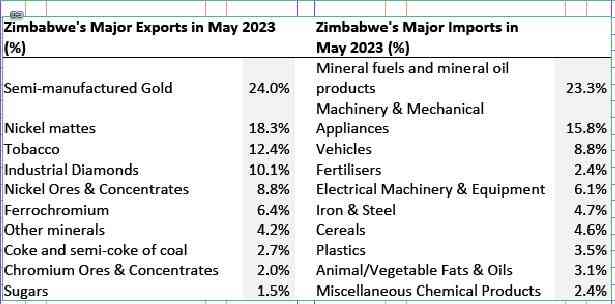
FOREIGN currency shortages or forex misappropriations? Does Zimbabwe earn enough foreign currency? From where? Are the flows sustainable? Misappropriations? Does Zimbabwe Earn Enough Foreign
An overview of forex receipts
Mark & Associates notes that Zimbabwe has reported a significant increase in foreign exchange earnings. In fact, these developments have helped Zimbabwe sustain a multi-currency regime over the years.
According to the Reserve Bank of Zimbabwe (RBZ), total foreign currency receipts in 2022 amounted to US$11,6 billion, representing a 17,3% increase from US$9,9 billion recorded in 2021. The growth in foreign currency receipts was largely driven by export proceeds (platinum and tobacco).
In this economic analysis report, we analyse Zimbabwe’s foreign exchange receipts. We also assess issues affecting the stability and predictability of the foreign exchange receipts. In conclusion, we provide key policy recommendations on how to develop sustainable foreign exchange flows in the future. The RBZ also reported that Zimbabwe’s external sector remained relatively strong in 2022 as evidenced by a surplus current account balance estimated at US$253 million. Overall, the sector benefited from (i) strong export performance due to favourable commodity prices for key exports and (ii) resilient remittance inflows.
Towards the US$12 billion target
The RBZ expects foreign currency receipts to hit the US$12 billion mark in 2023, riding on improved mining and agricultural output. The Bank also reported that total foreign currency receipts for five months ended May 31 2023 improved by 4% to US$4,64 billion versus US$4,45 billion in 2022.
Gold has continued to dominate as Zimbabwe’s single biggest export accounting for 24% of the total value of goods exported in May 2023. In second place are mineral mattes, an intermediate product (includes the large exports of platinum group metals). These mattes account for 18,3% of the total value of goods exported. Tobacco contributed 12,4% whilst industrial diamonds came in at 10,1% contribution.
- Zim has 2nd highest rising food prices: WB
- RBZ blocks Harare US dollar charges
- Industry cries foul over new export surrender requirements
- One stitch in time saves nine
Keep Reading
Mark & Associates highlights that Zimbabwe is a commodity exporter and the national current account has been mainly driven by merchandise trade developments over the past year, which, in turn, has been fuelled by a surge in commodity prices.
Thanks to its wealth of natural resources as Zimbabwe is benefiting from the current commodity price windfall.
However, an assessment must be made on the predictability and stability of such income streams in the outlook period given the volatile global economic environment.
According to the World Bank, global economic growth is set to slow down substantially. After growing 3,1% in 2021, the global economy is set to slow down to 2,1%, amid continued monetary policy tightening to rein in high inflation across different geographies. This has negative implications on demand and commodity prices.
Export proceeds
Cumulative export earnings or proceeds as of December 31 2022 were US$7,42 billion (representing 64% of total forex receipts) compared to US$6,37 billion earned in 2021. This represents a y-o-y growth of 16,5%. The mining sector export earnings accounted for 75,8% of the total export earnings in 2022, underlying the need for diversification and broadening of the export base.
Mineral contribution
It should be highlighted that minerals underpinned merchandise exports performance in 2022, growing by 12,3%, from US$5 billion in 2021 to US$5,6 billion, on account of higher production coupled with favourable commodity prices for key commodities. Agricultural exports increased from US$784,7 million in 2021 to US$1,15 billion in 2022, led by tobacco, following a good season. More recently, Zimbabwe has recorded the highest tobacco production in its 198 years of history. The country’s tobacco output in the ongoing 2023 marketing season currently stands at 261 million kilogrammes, surpassing the previous record of 259 million kilogrammes. An interesting highlight is that 85% of the tobacco is being produced by smallholder farmers, demonstrating a success in the empowerment of locals in different regions of the country.
Service trade
Trade in services recovered from the Covid-19 shock with travel, passengers transport and other key services trending up. Resultantly, services exports increased from US$215,7 million in 2021 to US$453,3 million in 2022. Travel services picked up, following the relaxation of the Covid-19 containment measures with people now moving freely across borders. Freight services also increased in line with increasing merchandise exports and imports.
International remittances
In 2022, total international remittances (diaspora remittances and NGOs) amounted to US$2,8 billion, an increase of 16% from US$2,4 billion in 2021. Of the total amount, diaspora remittances amounted to US$1,66 billion, a 16% increase from US$1,43 billion in 2021. Of the total diaspora remittances, 40% come from South Africa followed by the United Kingdom (25%). Other major sources are the United States of America (11%) and Australia (6%). The International Monetary Fund defines remittance inflow as the process, “where migrants send home part of their earnings in the form of either cash or goods to support their families, these transfers are known as workers’ or migrant remittances”.
They have been growing rapidly in the past years, and now represent the largest source of foreign direct investment for many developing economies.
Migration a driver of remittance flows
According to International Organisation for Migration (IOM), the major reason for emigration in Zimbabwe has to do with the lack of work opportunities.
Migration has essentially been a household strategy to address current and future risk. Dwindling opportunities for productive employment and career advancement as well as unequal employer–employee relations in the local labour market tend to influence decisions to emigrate.
The net migration rate for Zimbabwe in 2022 was -4.797 per 1 000 population. The net migration rate is the difference between the number of persons entering and leaving a country during the year per 1 000 persons. A negative rate indicates an excess of persons leaving the country.
Zimbabwe has lost skilled professionals such as lecturers, engineers, medical practitioners (doctors and nurses) and accountants to the USA, United Kingdom, Australia, and south Africa amongst many other countries. While Zimbabwe cannot do much to bring back these professionals, the benefit of having a large diaspora community has become evident. Most of these professionals living in more developed nations are being paid sufficiently well to make family remittances. Diaspora remittances now represent a significant number and have a direct impact on household incomes hence consumer demand.
Capital and financial accounts
Zimbabwe’s capital account balance was in positive territory in 2022 on the back of continued official capital transfers from the country’s external development partners, in support of on-going and new government projects. The capital account also continued to benefit from the support rendered by the country’s development partners. The support was spread on development programmes and projects across various priority sectors of the economy.
Zimbabwe's foreign direct investment inflows increased 36,8% in 2022 to US$342 million on the back of significant expansions and new projects, particularly in the mining sector, also explain the improvement in direct investment inflows.
However, the overall stock rose at a much slower pace of 5,53% over a decade. FDI inflows also continue to lag the peak of US$750 million, which was recorded in 2018.
Zimbabwe has struggled to attract investment mainly because of the perceived country risk. Zimbabwe is classified as a high-risk economy and ranks poorly in terms of political transformation and governance as per the Bertelsmann Stiftung’s Transformation Index (BTI).
The BTI assesses the transformation toward democracy and a market economy as well as the quality of political management in 129 countries.
Appropriation of Zim forex earnings
According to the RBZ, Zimbabwean banks processed foreign payments amounting to US$8,59 billion in 2022, representing a 23,1% increase in foreign payments from US$6,98 billion recorded for the same period in 2021. The major drivers of foreign payments were capital and intermediate goods as well as fuel and electricity, driven by increased global energy prices.
To be continued next week.
- Mark & Associates (M&A) Consulting Group is a strategic advisory firm focused on critical issues at the centre of economics, business, politics and society. (https://markassociates-portal. web.app). It offers a customised and adapted strategy consulting service, incorporating deep knowledge of both global and local dynamics. Its focus is on helping business and policy leaders make informed decisions based on cutting-edge insights. Founder and CEO of PiggyBankAdvisor Batanai Matsika is a director at M&A.






